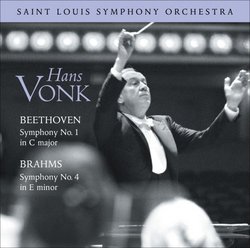| All Artists: Ludwig van Beethoven, Johannes Brahms, Hans Vonk, Saint Louis Symphony Orchestra Title: Beethoven: Symphony No. 1; Brahms: Symphony No. 4 Members Wishing: 0 Total Copies: 0 Label: Pentatone Release Date: 10/30/2007 Genre: Classical Styles: Historical Periods, Classical (c.1770-1830), Symphonies Number of Discs: 1 SwapaCD Credits: 1 UPC: 827949031861 |
Search - Ludwig van Beethoven, Johannes Brahms, Hans Vonk :: Beethoven: Symphony No. 1; Brahms: Symphony No. 4
 | Ludwig van Beethoven, Johannes Brahms, Hans Vonk Beethoven: Symphony No. 1; Brahms: Symphony No. 4 Genre: Classical |
Larger Image |
CD Details |
CD ReviewsSuperb Beethoven and Brahms from Saint Louis J Scott Morrison | Middlebury VT, USA | 11/29/2007 (5 out of 5 stars) "For the past twenty-five years or so the Saint Louis Symphony Orchestra has been one of the best in America, although it has never been included in the traditional Big Five. It got better and better over the years, particularly during the long tenure of Leonard Slatkin. Hans Vonk, the conductor of these live performances, was Slatkin's successor, and although not well-known in the US before he arrived in Saint Louis, he had been the chief conductor of the Dresden Staatskapelle and Dresden's Semper Opera for some years prior to his arrival here. A neurological illness while there necessitated a hiatus in his conducting career, but he recovered and did well medically for several years in Saint Louis until he again developed symptoms, this time diagnosed definitively as amyotrophic lateral sclerosis (in the US often called 'Lou Gehrig's disease') and he again had to stop conducting. He died of the illness in 2004. This recording was made in 1999 in the marvelous acoustic of Powell Hall, the orchestra's home hall, and there certainly is no evidence from these performances that Vonk is in anything but top form, as is the orchestra.
One of my criteria for performances of Beethoven's First Symphony is the voicing of the very first chord. Vonk passes my personal test for this, bringing out the oboe's leading tone rather than emphasizing the dominant. The reading of the symphony is lean, energetic, lighter than some, thus making the symphony, rightly, sound more classical than romantic. The symphony's third movement is called a minuet but it is a rumbustious thing more like the so-designated scherzos in Beethoven's later symphonies. And the symphony's second movement, the andante cantabile, sets the pattern for most of the slow movements in Beethoven's ensuing symphonies. The introduction of the finale is famous for its teasing hesitation to finish the first statement of the movement's main theme, adding another single note to it at each repeat of it, until it bursts, now completed, into the high spirits of the movement proper. A neat little symphony, this No. 1, and neatly played here. The Brahms Symphony No. 4 could hardly be more different than the Beethoven in that it is a massive and complex thing, arguably the best of all of Brahms's symphonies. In this performance the SLSO almost sounds like a different group, with a darker and more substantial sound, particularly in the strings, than in the Beethoven, fittingly so. The first movement is a sonata allegro which launches into the first theme with no preliminaries, the only Brahms first movement to do so. This theme is combined and contrasted with the rhythmic second theme in a magnificent working-out so typical of Brahms. The second movement features the heroic tones of the SLSO's principal horn, Roland Pandolfi, as well as gorgeous blending of the orchestra's winds, including the horn quartet. The third movement is possibly the most boisterous music Brahms ever wrote. The inclusion of piccolo and triangle lend a somewhat giddy mood to it. The finale is one of Brahms's most celebrated creations, a massive passacaglia on an eight-bar bass line that could have been written by Bach, and indeed it sounds very similar to a bass used by Bach in his Cantata 150, 'Nach dir, Herr, verlanget mich'. Brahms's construction of the passacaglia is strict, in the Baroque sense, and yet it could not have been written in any other than the late Romantic era. A towering masterpiece done full justice by the Saint Louis. Recorded sound is demonstration quality. Booklet notes by Paul Schiavo are exemplary. And because this is on the SLSO's own label, the booklet includes a listing of every player in the orchestra, something I wish more CD booklets would do. These musicians deserve to be known by name. Strongly recommended. Scott Morrison" |
